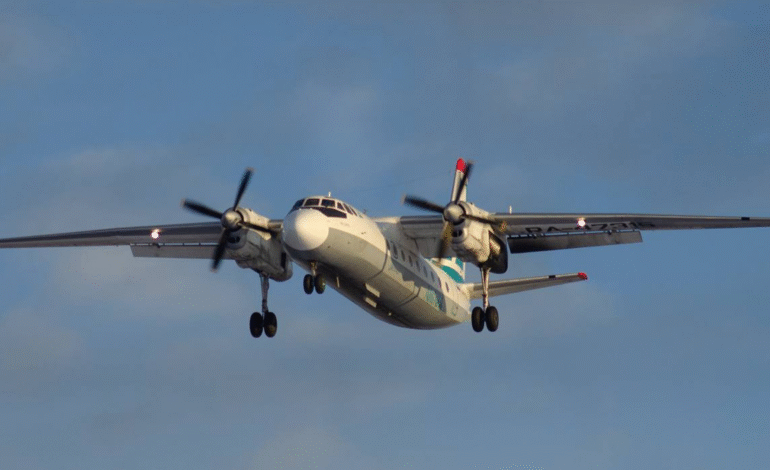Russian Antonov-24 Plane Crashes in Amur Region, 49 Dead

A tragic air disaster unfolded on Thursday in Russia’s far eastern Amur region, as a Soviet-era Antonov-24 passenger aircraft carrying 49 individuals crashed near the remote town of Tynda. Authorities confirmed that no one on board survived the crash, with the wreckage discovered by aerial rescuers amidst mountainous terrain approximately 16 kilometers from the intended destination.
The aircraft, operated by Angara Airlines, had been en route from Blagoveshchensk to Tynda when it vanished from radar during its final approach. Harsh weather conditions, notably thick fog and low visibility, are believed to have played a major role in the tragedy, with preliminary findings suggesting crew error during landing contributed to the mishap.
Aircraft Lost Contact During Approach in Adverse Weather
The Antonov-24, a twin-engine turboprop model designed in the Soviet era, took off from the city of Blagoveshchensk in the early hours of Thursday. Communication between the aircraft and air traffic controllers was lost shortly before its scheduled landing in Tynda, a remote town near the Russian-Chinese border.
According to official reports from the Russian Ministry of Emergency Situations, the plane disappeared from radar screens while descending through dense fog and cloud cover. Governor Vasily Orlov of Amur Oblast announced on his official Telegram channel that the aircraft had been carrying 43 passengers, including five children, along with a crew of six.
Search and rescue operations were promptly activated once the aircraft was declared missing. An Mi-8 helicopter operated by Rosaviatsiya, Russia’s civil aviation authority, later spotted the wreckage burning fuselage scattered along the slopes of a mountainous area just 10 miles from Tynda.
Emergency Teams Locate Wreckage With No Signs of Life
Upon locating the crash site, the aerial search team observed extensive fire damage to the fuselage, with no visible movement or response from the remains of the aircraft. There was no sign of survivors. Emergency responders were immediately dispatched to the mountainous area, with more than 25 personnel and five specialized ground units reaching the site within hours. Additional aircraft and crews remained on standby in case further support was needed.
The Russian Emergencies Ministry officially confirmed:
- “The burning fuselage has been found 16 kilometers from Tynda. There are no survivors among those on board.”
Helicopter footage and initial assessments by the rescue teams suggest that the aircraft collided with the terrain at high speed, causing the engines to ignite on impact. The force of the crash likely left no opportunity for survival, as most of the aircraft was reduced to charred metal and debris.
The Antonov-24: An Aging Aircraft Still in Use
The aircraft involved was an Antonov-24, a short-range, twin-turboprop aircraft that first entered service in the 1960s. Though considered durable and well-suited for rugged conditions, the Antonov-24 is increasingly viewed as outdated. Its analog cockpit systems and lack of modern safety technology make it vulnerable to accidents—especially in challenging weather or during instrument-based approaches.
At nearly 50 years old, the aircraft in question had long surpassed what is typically considered a safe operational lifespan for commercial aviation. The use of aging Soviet aircraft, particularly in remote regions like the Russian Far East and Siberia, continues to raise concerns about maintenance, modernization, and flight safety.
Angara Airlines, a Siberia-based regional airline, operates several of these vintage planes on domestic routes that connect remote towns with limited access to major transportation infrastructure. Following the incident, critics and aviation analysts have renewed calls for fleet upgrades and improved oversight in Russia’s regional aviation sector.
Preliminary Cause Points to Crew Error and Weather Conditions
Based on early analysis from regional aviation authorities, the crash is believed to have been caused by a combination of poor weather and human error. Low-lying clouds, fog, and reduced visibility likely made the approach to Tynda Airport hazardous. Investigators are examining whether the flight crew misjudged altitude or descent timing during their landing procedure.
Governor Orlov acknowledged the complexity of the situation, stating:
- “Initial data suggests that weather conditions at the time of the approach were far from ideal. The terrain, coupled with limited visibility, presented a severe risk.”
The final moments of the flight, including the pilots’ actions and cockpit recordings, are being analyzed by Russia’s Interstate Aviation Committee (IAC) and the national emergency task force. No evidence has yet emerged of engine failure or sabotage. The investigation will also scrutinize the aircraft’s maintenance logs and previous inspection reports.
Aviation Tragedy Follows Two Recent Major Plane Crashes
This is the third deadly aviation incident in less than two months, highlighting a troubling global pattern in aviation safety. Just last month, on July 21, a Bangladeshi Air Force fighter jet tragically crashed into the Milestone School and College in Dhaka, killing at least 20 people and injuring over 170—mostly students and staff.
A month earlier, on June 12, an Air India Boeing 787 Dreamliner departing from Ahmedabad crashed shortly after takeoff due to a thrust loss, colliding with a nearby medical college complex. That disaster killed 278 people, including passengers and civilians on the ground.
These recent accidents now followed by the Amur region crash have led aviation experts to call for greater attention to pilot training, aircraft age, weather preparedness, and air traffic infrastructure, especially in developing and geographically isolated regions.
Angara Airlines Faces Scrutiny Over Safety Practices
In light of this tragedy, Angara Airlines will now face an intense probe into its fleet operations, maintenance protocols, and safety training. The airline has operated domestically within Siberia and eastern Russia for over a decade, often servicing routes deemed non-viable by larger carriers.
While Angara has not previously experienced a crash of this magnitude, questions are being raised about their continued reliance on older aircraft and limited navigation aids. This incident may lead to an overhaul of regional aviation safety requirements, including mandatory aircraft retirement ages and the implementation of digital navigation and safety systems for all commercial flights.
Recovery and Mourning Underway in Amur Region
Recovery efforts are expected to continue over the coming days. The crash site, located in rugged terrain and surrounded by forest, presents logistical difficulties. Rescuers will need to recover remains, analyze debris, and eventually begin the long task of returning victims to their families.
A nationwide moment of mourning has been proposed by several Russian officials, with flags flown at half-mast in parts of the Amur region. Local schools, businesses, and airports observed a moment of silence on Friday in honor of the lives lost.
Support services, including grief counselors and compensation assistance, are being made available to victims’ families. Many of the passengers were believed to be residents returning home from business or medical trips in Blagoveshchensk.
Aviation Safety Reforms Expected Following Investigation
As the investigation progresses, broader reforms are expected. Russia’s Federal Air Transport Agency is considering imposing:
- Stricter weather minimums for landings in eastern regions
- Mandatory aircraft upgrades or phased retirements
- Simulation-based crew training for poor visibility navigation
- Emergency locator enhancements for real-time aircraft tracking
Additionally, aviation experts stress the need for improved infrastructure at smaller regional airports like Tynda, including instrument landing systems (ILS) and automated terrain warning systems that can assist in poor visibility scenarios.
A Wake-Up Call for Aviation Oversight
The crash of the Antonov-24 in Russia’s Amur region marks not only a devastating loss of life but also a significant blow to aviation confidence in Russia’s vast eastern territories. As officials continue to investigate the sequence of failures that led to the incident, the global aviation community watches closely, hoping that meaningful reforms will follow to prevent similar tragedies in the future.








2 Comments
[…] of the best fights of the year. Nurmagomedov, the undefeated lightweight champion from Dagestan, Russia, emerged victorious, but the close nature of the match left fans eager for a rematch. In the […]
[…] reason Su-57 production in India looks possible is India’s existing experience with Russian aircraft. Hindustan Aeronautics Limited (HAL) already produces Su-30MKI fighters under license from Russia […]
Comments are closed.